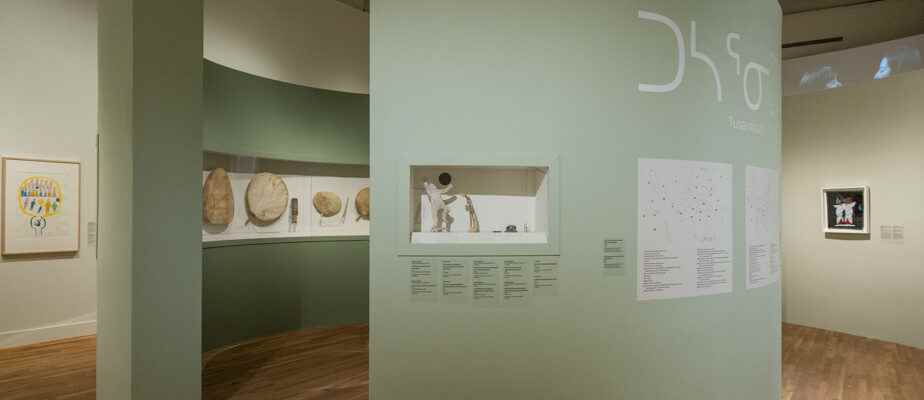Inuit visual art has been inspired for centuries by their musical tradition. This is the theme of the exhibition Tusarnitut presented until March 12 at the Montreal Museum of Fine Arts (MMFA). A deployment focused on the throat singing and drum dancing of the Inuit of Canada and the entire circumpolar region.
The MMFA invites us to a beautiful cultural story this winter. A story of resilience and the perpetuation of knowledge, traditions and talents, from the perspective of music and its celebration by the Inuit in the form of drawings, lithographs, engravings, masks and sculptures. A tribute to an ancestral tradition, as indicated by guest curator Jean-Jacques Nattiez, ethnomusicologist and professor emeritus at the University of Montreal.
The show is well scripted. On the left, when you enter, everything about the drum dances and, on the right, the throat singing. At the entrance, two geographical maps locate the Inuit communities we are talking about, from the Chukchi of Siberia to the Labradormiut (the Inuit of Labrador), via the Inuit of Quebec (Nunavik) who are called the Nunavimmiut.
Drums, masks and shamanism
First interesting work, the print Two katajjaniq players, by Inukjuak artist Lucassie Echalook. Katajjaniq is the practice of throat singing. This engraving is famous because it appeared on the cover of the first two albums of throat singing music, Inuit games and songsa record by Jean-Jacques Nattiez produced by UNESCO in 1978, and another made in Toronto in 1980.

PHOTO MARTIN TREMBLAY, THE PRESS
Two katajjaniq players1974, Lucassie Echalook, stonecut
We then explore shamanism among the Inuit, at the origin of drum dancing and throat singing. With shaman amulets, a whalebone and ivory sculpture of a drummer – by artist Karoo Ashevak (1940-1974) – and another sculpture of Sedna, the Inuit goddess of the sea. had his stumps cut on the edge of a boat and gave birth to the animals,” says Jean-Jacques Nattiez, who explains that Inuit shamanism began to disappear in Canada when the evangelization of Christian missionaries began. This is not the case for other shamanic communities in the world, notably the Tsaatan, in Siberian Mongolia.

PHOTO CHRISTINE GUEST, PROVIDED BY THE MMFA
Untitled (Drum Player), circa 1973, Karoo Ashevak (1940-1974). MMFA Collection. © Public Trustee of Nunavut, Estate of Karoo Ashevak.
You can admire two Igloolik masks that illustrate the tivajuut, a fertility ritual held in an igloo during which two men don a mask, one representing a man, the other a woman. The ritual is accompanied by a song and music that can be enjoyed on site. The music was recorded in this village of Nunavut by Jean-Jacques Nattiez, who recounts his epic around the arts, songs and dances of the Inuit in a splendid work of art, 500 pages, entitled The music that comes from the cold.
Two photographs are of great interest in the exhibition. They represent a drum circle and a mask found in 1970 by anthropologist and missionary father Guy Mary-Rousselière (1913-1994), an Oblate who translated the songs of Inuit shamans into French.

PHOTO MARTIN TREMBLAY, THE PRESS
The drum circle and mask found in 1970 by missionary Guy Mary-Rousselière
Jean-Jacques Nattiez explains the importance of this discovery made on Baffin Island, near Mittimatalik (Pond Inlet):
Since the circle is central in Inuit art and in their social life (igloo), the museum’s scenographer, Laurence Boutin Laperrière, has judiciously created a central circular space which contains a model of an igloo explaining the drum dance ritual as well as than a series of drums from the circumpolar region.
Throat singing in the spotlight
The second part is devoted to throat singing with videos and drawings, with representations of animals. Women would throat sing when their spouses were out hunting, says Jean-Jacques Nattiez. Moreover, it is interesting to discover Chukchi women doing throat singing 8000 km from Nunavut. “We watch that and it’s fascinating to see that it’s exactly the same choreography,” says Mr. Nattiez.
The exhibition ends with contemporary Inuit music. A decorated electric guitar, the sculpture of an Inuit “fiddler” and even an Inuit playing the accordion! As well as an installation by Nancy Saunders (Niap) where soapstone sculptures represent the vocal cords that are the source of throat singing that can be heard through headphones. Ingenious.
-

PHOTO ROMAIN GUILBAULT, PROVIDED BY THE MMFA
ᑲᑕᔾᔭᐅᓯᕙᓪᓛᑦ Katajjausivallaat, rocking rhythm, 2018, Nancy Saunders (Niap) (1986-—). MMFA Collection.
-

PHOTO CHRISTINE GUEST, PROVIDED BY THE MMFA
power of words, 2005, Mattiusi Iyaituk (1950-—). MMFA Collection.
-

PHOTO CHRISTINE GUEST, PROVIDED BY THE MMFA
Keepers of the Katajjaniq, 1992, Kenojuak Ashevak (1927-2013). Jean-Jacques Nattiez collection. Reproduced with permission from Dorset Fine Arts.
1/3
Note that in addition to Jean-Jacques Nattiez, the exhibition was created by Lisa Qiluqqi Koperqualuk, curator-mediator of Inuit art at the museum, in collaboration with Charissa von Harringa, associate curator, also at the MMFA. Good visit !

